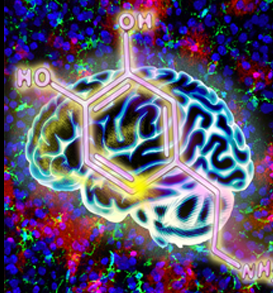
A recent study published in Neuroscience Bulletin demonstrated that astrocytic gap junctions facilitate the abnormal neuronal synchrony in young autistic model MeCP2 overexpressing mice, revealing the potential role of the astrocyte network in the pathogenesis of autism. This work was performed by researchers in Dr. XU Hua-tai’s lab at CEBSIT, State Key Laboratory of Neuroscience

A recent study by a team of Chinese researchers about how the brain encodes and stores sequences was published in the Science journal on Feb 11. The study was a collaboration between CEBSIT, the Shanghai Center for Brain Science and Brain-Inspired Technology and Peking University's school of life sciences.The study involved training macaques to memorize spatial sequences. Macaques are most similar to humans in terms of brain structure and functions, and therefore are the best subjects for studying complex cognitive functions, according to the team.

A recent study published in Movement Disorders demonstrated that the truncated spastin may damage the corticospinal tracts in hereditary spastic paraplegia (HSP) patients via an isoform-specific toxic effect. This work was performed by Dr. LIU Jing-Yu’s lab at ION.The LIU’s lab successfully identified the pathogenic gene SPAST in three hereditary spastic paraplegia (HSP, SPG4 subtype) families by linkage analysis and Sanger sequencing. Further functional analyses of the mutant proteins by Western blotting and immunofluorescence showed that the truncated SPASTIN encoded by the mutant SPAST can disturb microtubule dynamics through the isoform-specific effects.

Two recent studies published in The Journal of Neuroscience and National Science Review characterized the coding mechanism of multimodal somatosensations in the primary somatosensory cortex (S1), and revealed the neural mechanism of itch perceptual coding in S1. These studies were performed by researchers in Dr. SUN Yangang’s lab and Dr. XU Ninglong’s lab at CEBSIT. These studies have successfully delineated the cortical coding mechanism of itch in free-moving animals, and has paved the way for a deeper understanding of the processing and integration of multimodal somatosensory information in the cortex.

A recent study published in Cell Reports reveals the evolution and the neural correlates of cooperation. This work was performed by researchers in Dr. WANG Zuoren’s Lab at CEBSIT.

A recent study published in Cell Reports found that, compared with synchronous visual and inner ear vestibular stimuli, macaques discriminated self-motion directions more precisely when visual stimuli appeared about 250-500 ms earlier than vestibular stimuli. This result, although surprising at the first glance, suggests that in natural spatial navigation, the brain typically integrates multiple senses in a temporal-dynamics-incongruent way, i.e., integration of visual velocity and vestibular acceleration. This work was performed by researchers in Dr. GU Yong’s lab.

A recent study published in Cell Reports reveals that direct and indirect pathway striatal neurons exhibit temporally distinct activity patterns and differentially modulate basal ganglia output responses. This work was performed by researchers in Dr. YAO Haishan’s Lab.

A recent study published in Cell Reports demonstrated that the deficiency of PRRT2 facilitates the induction of cerebellar spreading depolarization (SD), which mediates paroxysmal movement disorder. This work was performed by Dr. XIONG Zhiqi’s Lab.

A recent study published in Neuroscience Bulletin demonstrated that autism-related intronic mutation of CHD7 affecting neural development. This work was performed by researchers in Dr. QIU Zilong’s Lab and Dr. CHEN Yuejun’s lab at the Institute of Neuroscience, Center for Excellence in Brain Science and Intelligence Technology of the Chinese Academy of Sciences, State Key Laboratory of Neuroscience, and Dr. DU Yasong at Shanghai Mental Health Center, School of Medicine, Shanghai Jiao Tong University.

Combining psychophysics in human subjects, neurophysiological recordings in cats and mathematical modelling, a recent study from Dr. WANG Wei’s lab reveals how stimulus size and the receptive-field structure of subcortical ON- and OFF-cells contributes to the parallel asymmetries between neural and perceptual responses to bright vs. dark afterimages.
A recent study published in Nature revealed the structural basis of antidepressant ketamine action on human NMDA receptors. This work was performed by researchers in Dr. ZHU Shujia’s Lab and Dr. LUO Cheng’s team. This work has provided the structural basis of ketamine binding and action on human NMDA receptors, and paved the way for future development of ketamine-based antidepressants.

A recent study from Dr. ZHU Shujia’s Laboratory published in Neuron uncovered the gating mechanism of human GluN1-GluN2A NMDA (N-methyl-D-aspartic acid) receptor using cryo electron microscopy (Cryo-EM) and discovered a novel modulator niche resides in the linker cavity.

A recent study published in the Journal of Neuroscience demonstrated that damage to the substantia nigra (SN) correlates with basal ganglia dysfunction and poor sequencing performance in Parkinson’s disease (PD). This work was performed by researchers in Dr. YE Zheng’s Lab and Prof. JIN Lirong’s team.

A recent study published in Cell Reports demonstrated that FGF13 gene acts as an intrinsic regulator in the maintenance of the self-renewal and proliferation of NSCs in the hippocampus during the postnatal development. This work was jointly performed by Dr. ZHOU Jiawei’s Lab and Dr. HU Gang’s group.

A recent study published in Nature Communications identified a pathway from the premotor cortex to the superior colliculus that is critical during memory-guided decisions, and dissected the neural circuit mechanisms underlying motor planning. This study was conducted by Xu Ninglong’s lab.
